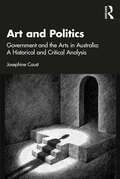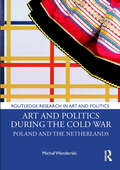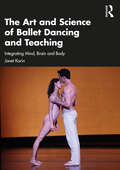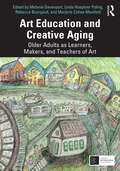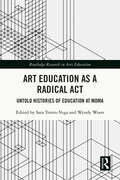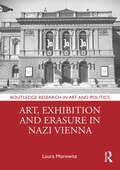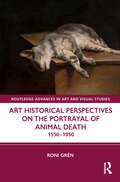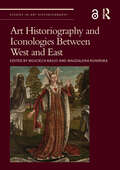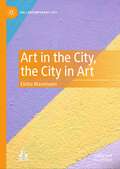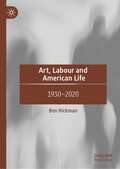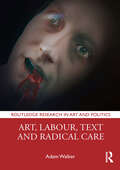- Table View
- List View
The Art and Philosophy of the Garden
by David Fenner Ethan FennerThe Art and Philosophy of the Garden offers the first authoritative and comprehensive philosophical discussion of the aesthetics of gardens. Philosopher David Fenner and horticulturist Ethan Fenner address such questions as: what is a garden? Are some gardens works of art? What does it mean to appreciate gardens aesthetically? Given that gardens are always changing in a variety of ways, how is it possible to compare, evaluate, or find meaning in them? How can we interpret gardens? How do we value gardens and gardening? While grounded in Western thought, Fenner and Fenner bring to bear global ideas and examples of gardens and gardening techniques. Inspired by a surge of philosophical interest in gardening, Fenner and Fenner argue that some gardens are indeed works of art. They explore how we might understand the aesthetic properties of gardens, and focus on what it means to "read" the formal aspects of gardens -- what the authors call "garden form" -- as a basis for interpreting a garden. They discuss the intersection of gardens/gardening and value: questions such as what sort of value gardens possess; whether and how ethics are relevant to gardens; how gardens may be evaluated and compared; and the value of the practice of gardening. This comprehensive philosophical discussion on the aesthetics of gardens and gardening will not only interest those concerned with garden theory but will interest any thoughtful and intellectually curious gardener.
Art and Politics: Government and the Arts in Australia: A Historical and Critical Analysis
by Josephine CaustAustralian governments at all levels have been engaged with arts and culture in many different forms since the beginning of European settlement. The way this has occurred is documented and analysed here, both from an historical and critical perspective. Changing understandings of culture and the significance of Indigenous Culture to Australia receive special attention. While the focus is primarily directed to Federal Government engagement, there is also consideration paid to both state and local government involvement. There is attention paid to the censorship of arts practice by governments as well as the direct interventions by politicians in arts practice. Different approaches to the arts by governments are also considered, as well as attempts to develop a national cultural policy. The impact of the recent pandemic is addressed and various research reports about the arts sector and its relationship with government are also noted. There is then a final discussion about some issues that governments could address in the future, that might ensure a more sustainable Australian arts sector. This book will be of particular interest to scholars of contemporary arts, arts management, cultural history, public policy and cultural policy. It may also interest bureaucrats and politicians.
Art and Politics: Government and the Arts in Australia: A Historical and Critical Analysis
by Josephine CaustAustralian governments at all levels have been engaged with arts and culture in many different forms since the beginning of European settlement. The way this has occurred is documented and analysed here, both from an historical and critical perspective. Changing understandings of culture and the significance of Indigenous Culture to Australia receive special attention. While the focus is primarily directed to Federal Government engagement, there is also consideration paid to both state and local government involvement. There is attention paid to the censorship of arts practice by governments as well as the direct interventions by politicians in arts practice. Different approaches to the arts by governments are also considered, as well as attempts to develop a national cultural policy. The impact of the recent pandemic is addressed and various research reports about the arts sector and its relationship with government are also noted. There is then a final discussion about some issues that governments could address in the future, that might ensure a more sustainable Australian arts sector. This book will be of particular interest to scholars of contemporary arts, arts management, cultural history, public policy and cultural policy. It may also interest bureaucrats and politicians.
Art and Politics During the Cold War: Poland and the Netherlands (Routledge Research in Art and Politics)
by Michał WenderskiDrawing on thousands of historical documents from Polish and Dutch archives, this book explores Cold War cultural exchange between so-called ‘smaller powers’ of this global conflict, which thus far has been predominately explored from the perspective of the two superpowers or more pivotal countries. By looking at how cultural, artistic and scholarly relations were developed between Poland and the Netherlands, Michał Wenderski sheds new light on the history of the Cultural Cold War that was not always orchestrated solely by its main players. Less pivotal states – for example, Poland and the Netherlands – likewise intentionally created their international cultural policies and shaped their cultural exchange with countries from the other side of the Iron Curtain. This study reconstructs these policies and identifies the varying factors that influenced them – both official and less formal. The book will be of interest to scholars working in art history, history of the Cold War, post-war European history, international cultural relations, Dutch studies and Polish studies.
Art and Politics During the Cold War: Poland and the Netherlands (Routledge Research in Art and Politics)
by Michał WenderskiDrawing on thousands of historical documents from Polish and Dutch archives, this book explores Cold War cultural exchange between so-called ‘smaller powers’ of this global conflict, which thus far has been predominately explored from the perspective of the two superpowers or more pivotal countries. By looking at how cultural, artistic and scholarly relations were developed between Poland and the Netherlands, Michał Wenderski sheds new light on the history of the Cultural Cold War that was not always orchestrated solely by its main players. Less pivotal states – for example, Poland and the Netherlands – likewise intentionally created their international cultural policies and shaped their cultural exchange with countries from the other side of the Iron Curtain. This study reconstructs these policies and identifies the varying factors that influenced them – both official and less formal. The book will be of interest to scholars working in art history, history of the Cold War, post-war European history, international cultural relations, Dutch studies and Polish studies.
The Art and Science of Ballet Dancing and Teaching: Integrating Mind, Brain and Body
by Janet KarinThis book offers an inside view of ballet as the art form we see on stages today, detailing how expressive movement is initiated and controlled, and discussing the importance of embedding creativity and expressivity within ballet technique from the dancer’s first lesson to their final performance. Janet Karin O.A.M. promotes ballet as a holistic art form resulting from the integration of mind, brain and body, and describes the motor control factors that can enhance or interfere with achievement. Throughout, professional dancers’ personal experiences illuminate the text, from the euphoria of ‘flow’ to the search for creativity and harmony, from the debilitating effects of anxiety, trauma and pain to the reward of artistic autonomy. Teaching is presented from a philosophical viewpoint, enriching and extending the child’s innate movement skills and expressive power. Practical yet reflective, this is an essential guide for dancers as well as dance educators and students.
The Art and Science of Ballet Dancing and Teaching: Integrating Mind, Brain and Body
by Janet KarinThis book offers an inside view of ballet as the art form we see on stages today, detailing how expressive movement is initiated and controlled, and discussing the importance of embedding creativity and expressivity within ballet technique from the dancer’s first lesson to their final performance. Janet Karin O.A.M. promotes ballet as a holistic art form resulting from the integration of mind, brain and body, and describes the motor control factors that can enhance or interfere with achievement. Throughout, professional dancers’ personal experiences illuminate the text, from the euphoria of ‘flow’ to the search for creativity and harmony, from the debilitating effects of anxiety, trauma and pain to the reward of artistic autonomy. Teaching is presented from a philosophical viewpoint, enriching and extending the child’s innate movement skills and expressive power. Practical yet reflective, this is an essential guide for dancers as well as dance educators and students.
Art Collecting and Middle Class Culture from London to Brighton, 1840–1914 (Routledge Research in Art History)
by David AdelmanThis study explores the interplay between money, status, politics and art collecting in the public and private lives of members of the wealthy trading classes in Brighton during the period 1840–1914.Chapters focus on the collecting practices of five rich and upwardly mobile Victorians: William Coningham (1815–84), Henry Hill (1813–82), Henry Willett (1823–1905) and Harriet Trist (1816–96) and her husband John Hamilton Trist (1812–91). The book examines the relationship between the wealth of these would-be members of the Brighton bourgeoisie and the social and political meanings of their art collections paid for out of fortunes made from sugar, tailoring, beer and wine. It explores their luxury lifestyles and civic activities including the making of Brighton museum and art gallery, which reflected a paradoxical mix of patrician and liberal views, of aristocratic aspiration and radical rhetoric. It also highlights the centrality of the London art world to their collecting facilitated by the opening of the London to Brighton railway line in 1841.The book will be of interest to scholars working in art history, museum studies and British history.
Art Collecting and Middle Class Culture from London to Brighton, 1840–1914 (Routledge Research in Art History)
by David AdelmanThis study explores the interplay between money, status, politics and art collecting in the public and private lives of members of the wealthy trading classes in Brighton during the period 1840–1914.Chapters focus on the collecting practices of five rich and upwardly mobile Victorians: William Coningham (1815–84), Henry Hill (1813–82), Henry Willett (1823–1905) and Harriet Trist (1816–96) and her husband John Hamilton Trist (1812–91). The book examines the relationship between the wealth of these would-be members of the Brighton bourgeoisie and the social and political meanings of their art collections paid for out of fortunes made from sugar, tailoring, beer and wine. It explores their luxury lifestyles and civic activities including the making of Brighton museum and art gallery, which reflected a paradoxical mix of patrician and liberal views, of aristocratic aspiration and radical rhetoric. It also highlights the centrality of the London art world to their collecting facilitated by the opening of the London to Brighton railway line in 1841.The book will be of interest to scholars working in art history, museum studies and British history.
Art Education and Creative Aging: Older Adults as Learners, Makers, and Teachers of Art
This text explores how art education can meaningfully address the needs of older adults as learners, makers, and teachers of art in formal and informal settings. It combines perspectives of museum educators, teacher preparation professors, art therapists, teaching artists, and older artists on what is meant by Creative Aging and the ways art education can support the health and well-being of this population. Most importantly, the book discusses what the field of art education can gain from older adult learners and creators.Chapters are organized into five sections: Creatively Aging, Meeting Older Adults’ Unique Needs, Intergenerational Art Education, Engaging Older Adults With Artworks and Objects, and In Our Own Voices: Older Adults as Learners, Makers, and Teachers. Within each section, contributors investigate themes critical to art education within aging populations such as memory loss, disability, coping with life transitions, lifelong learning, intergenerational relationships, and personal narrative. The final section focuses on accounts from older adult artists/educators, offering insights and proposing new directions for growing older creatively.Though ideal for art education faculty and students in graduate and undergraduate settings, as well as art education scholars and those teaching in multigenerational programs within community settings, this book is an expansive resource for any artist, student, or scholar interested in the links among health, well-being, and arts participation for older adults.
Art Education and Creative Aging: Older Adults as Learners, Makers, and Teachers of Art
by Melanie Davenport Linda Hoeptner Poling Rébecca Bourgault Marjorie Cohee ManifoldThis text explores how art education can meaningfully address the needs of older adults as learners, makers, and teachers of art in formal and informal settings. It combines perspectives of museum educators, teacher preparation professors, art therapists, teaching artists, and older artists on what is meant by Creative Aging and the ways art education can support the health and well-being of this population. Most importantly, the book discusses what the field of art education can gain from older adult learners and creators.Chapters are organized into five sections: Creatively Aging, Meeting Older Adults’ Unique Needs, Intergenerational Art Education, Engaging Older Adults With Artworks and Objects, and In Our Own Voices: Older Adults as Learners, Makers, and Teachers. Within each section, contributors investigate themes critical to art education within aging populations such as memory loss, disability, coping with life transitions, lifelong learning, intergenerational relationships, and personal narrative. The final section focuses on accounts from older adult artists/educators, offering insights and proposing new directions for growing older creatively.Though ideal for art education faculty and students in graduate and undergraduate settings, as well as art education scholars and those teaching in multigenerational programs within community settings, this book is an expansive resource for any artist, student, or scholar interested in the links among health, well-being, and arts participation for older adults.
Art Education as a Radical Act: Untold Histories of Education at MoMA (Routledge Research in Arts Education)
by Sara Torres-Vega Wendy WoonThis comprehensive volume highlights and centers untold histories of education at the Museum of Modern Art (MoMA) from 1937 to 2020, using the critical voices of artists, scholars, designers, and educators. Exploring these histories as transformative and paradigm-shifting in museum education, it elevates MoMA educators as vocal advocates for harnessing the educational power that museums inherently possess.Divided into three interlinked parts, the first sheds light on the early educational endeavors of the museum while analyzing the context of art education in the United States. The second part focuses on the tenures of Victor D’Amico and Betty Blayton, utilizing the MoMA archives as a primary resource. It includes essays by Ellen Winner, Luis Camnitzer, Susan E. Cahan, Michelle Millar Fisher, HECTOR (Jae Shin & Damon Rich), Gregory Sholette, Carol Duncan, Moreen Maser, Nana Adusei-Poku, Carmen Mörsch, Rika Burnham, Donna M. Jones, and José Ortiz. The third part presents the perspectives of William Burback, Philip Yenawine, Patterson Sims, Deborah F. Schwartz, and Wendy Woon as former MoMA Directors of Education in their own words and considers the forces that shaped their work. This timely and unique exploration ultimately aims to trace and understand the fundamental and evolving concerns of a seemingly underexamined profession constantly striving to maintain relevance in an environment marked by institutional, social, and political uncertainty. Exploring the radical acts undertaken to keep the museum true to its original promise, it delineates the paradox whereby education is both central and invisible to the identity of MoMA and museums more broadly and re-centers the conception of the museum as an educational institution.It is designed for scholars, researchers, and post-graduate students interested in arts education, visual literacy, museum studies, and communication studies.
Art Education as a Radical Act: Untold Histories of Education at MoMA (Routledge Research in Arts Education)
This comprehensive volume highlights and centers untold histories of education at the Museum of Modern Art (MoMA) from 1937 to 2020, using the critical voices of artists, scholars, designers, and educators. Exploring these histories as transformative and paradigm-shifting in museum education, it elevates MoMA educators as vocal advocates for harnessing the educational power that museums inherently possess.Divided into three interlinked parts, the first sheds light on the early educational endeavors of the museum while analyzing the context of art education in the United States. The second part focuses on the tenures of Victor D’Amico and Betty Blayton, utilizing the MoMA archives as a primary resource. It includes essays by Ellen Winner, Luis Camnitzer, Susan E. Cahan, Michelle Millar Fisher, HECTOR (Jae Shin & Damon Rich), Gregory Sholette, Carol Duncan, Moreen Maser, Nana Adusei-Poku, Carmen Mörsch, Rika Burnham, Donna M. Jones, and José Ortiz. The third part presents the perspectives of William Burback, Philip Yenawine, Patterson Sims, Deborah F. Schwartz, and Wendy Woon as former MoMA Directors of Education in their own words and considers the forces that shaped their work. This timely and unique exploration ultimately aims to trace and understand the fundamental and evolving concerns of a seemingly underexamined profession constantly striving to maintain relevance in an environment marked by institutional, social, and political uncertainty. Exploring the radical acts undertaken to keep the museum true to its original promise, it delineates the paradox whereby education is both central and invisible to the identity of MoMA and museums more broadly and re-centers the conception of the museum as an educational institution.It is designed for scholars, researchers, and post-graduate students interested in arts education, visual literacy, museum studies, and communication studies.
Art, Exhibition and Erasure in Nazi Vienna (Routledge Research in Art and Politics)
by Laura MorowitzThis book examines three exhibitions of contemporary art held at the Vienna Künstlerhaus during the period of National Socialist rule and shows how each attempted to culturally erase elements anathema to Nazi ideology: the City, the Jewess and fin-de-siècle Vienna. Each of the exhibits was large scale and ambitious, part of a broader attempt to situate Vienna as the cultural capital of the Reich, and each aimed to reshape cultural memory and rewrite history. Applying illuminating theories on memory studies, collective and public memory, and notions of "memoricide," this is the first book in English to focus on visual culture in the period when Austria was erased as a nation and incorporated into the Third Reich as "Ostmark." The organization, content and publications surrounding these three exhibits are explored in depth and set against the larger political changes and dangerous ideologies they reflect. The book will be of interest to scholars working in art history, museum studies, cultural history, memory studies, art and politics and Holocaust studies.
Art, Exhibition and Erasure in Nazi Vienna (Routledge Research in Art and Politics)
by Laura MorowitzThis book examines three exhibitions of contemporary art held at the Vienna Künstlerhaus during the period of National Socialist rule and shows how each attempted to culturally erase elements anathema to Nazi ideology: the City, the Jewess and fin-de-siècle Vienna. Each of the exhibits was large scale and ambitious, part of a broader attempt to situate Vienna as the cultural capital of the Reich, and each aimed to reshape cultural memory and rewrite history. Applying illuminating theories on memory studies, collective and public memory, and notions of "memoricide," this is the first book in English to focus on visual culture in the period when Austria was erased as a nation and incorporated into the Third Reich as "Ostmark." The organization, content and publications surrounding these three exhibits are explored in depth and set against the larger political changes and dangerous ideologies they reflect. The book will be of interest to scholars working in art history, museum studies, cultural history, memory studies, art and politics and Holocaust studies.
Art Historical Perspectives on the Portrayal of Animal Death: 1550–1950 (Routledge Advances in Art and Visual Studies)
by Roni GrénThis study concentrates on the discourses around animal death in arts and the ways they changed over time.Chapter topics span from religious symbolism to natural history cabinets, from hunting laws to animal rights, from economic history to formalist views on art. In other words, the book asks why artists have represented animal death in visual culture, maintaining that the practice has, through the whole era, been a crucial part of the understanding of our relation to the world and our identity as humans. This is the first truly integrative book-length examination of the depiction of dead animals in Western art.The book will be of interest to scholars working in art history, animal studies, and cultural history.
Art Historical Perspectives on the Portrayal of Animal Death: 1550–1950 (Routledge Advances in Art and Visual Studies)
by Roni GrénThis study concentrates on the discourses around animal death in arts and the ways they changed over time.Chapter topics span from religious symbolism to natural history cabinets, from hunting laws to animal rights, from economic history to formalist views on art. In other words, the book asks why artists have represented animal death in visual culture, maintaining that the practice has, through the whole era, been a crucial part of the understanding of our relation to the world and our identity as humans. This is the first truly integrative book-length examination of the depiction of dead animals in Western art.The book will be of interest to scholars working in art history, animal studies, and cultural history.
Art Historiography and Iconologies Between West and East (ISSN)
by Wojciech Ba 322 Us Magdalena Kuni 324 SkaThis volume explores a basic question in the historiography of art: the extent to which iconology was a homogenous research method in its own immutable right. By contributing to the rejection of the universalizing narrative, these case studies argue that there were many strands of iconology.Methods that differed from the ‘canonised’ approach of Panofsky were proposed by Godefridus Johannes Hoogewerff and Hans Sedlmayr. Researchers affiliated with the Warburg Institute in London also chose to distance themselves from Panofsky’s work. Poland, in turn, was the breeding ground for yet another distinct variety of iconology. In Communist Czechoslovakia there were attempts to develop a ‘Marxist iconology’. This book, written by recognized experts in the field, examines these and other major strands of iconology, telling the tale of iconology’s reception in the countries formerly behind the Iron Curtain. Attitudes there ranged from enthusiastic acceptance in Poland, to critical reception in the Soviet Union, to reinterpretation in Czechoslovakia and the German Democratic Republic, and, finally, to outright rejection in Romania.The book will be of interest to scholars working in art history, visual studies, and historiography.
Art Historiography and Iconologies Between West and East (ISSN)
by Wojciech Bałus Magdalena KunińskaThis volume explores a basic question in the historiography of art: the extent to which iconology was a homogenous research method in its own immutable right. By contributing to the rejection of the universalizing narrative, these case studies argue that there were many strands of iconology.Methods that differed from the ‘canonised’ approach of Panofsky were proposed by Godefridus Johannes Hoogewerff and Hans Sedlmayr. Researchers affiliated with the Warburg Institute in London also chose to distance themselves from Panofsky’s work. Poland, in turn, was the breeding ground for yet another distinct variety of iconology. In Communist Czechoslovakia there were attempts to develop a ‘Marxist iconology’. This book, written by recognized experts in the field, examines these and other major strands of iconology, telling the tale of iconology’s reception in the countries formerly behind the Iron Curtain. Attitudes there ranged from enthusiastic acceptance in Poland, to critical reception in the Soviet Union, to reinterpretation in Czechoslovakia and the German Democratic Republic, and, finally, to outright rejection in Romania.The book will be of interest to scholars working in art history, visual studies, and historiography.
Art History, Narratology, and Twentieth-Century Chinese Art (Routledge Research in Art History)
by Lian DuanThis study constructs a framework of narratology for art history and rewrites the development of twentieth-century Chinese art from a narratological perspective. Theoretically and methodologically oriented, this is a self-reflective meta-art history studying the art historical narratives while narrating the story of modern and contemporary Chinese art. Thus, this book explores the three layers of narrative within the narratological framework: the first-hand fabula, the secondary narration, and the tertiary narrativization. With this tertiary narrativization, the reader-author presents three types of narrative: the grand narrative of the central thesis of this book, the middle-range narrative of the chapter theses, and case analyses supporting these theses. The focus of this tertiary narrativization is the interaction between Western influence on Chinese art and the Chinese response to this influence. The central thesis is that this interaction conditioned and shaped the development of Chinese art at every historical turning point in the twentieth century. The book will be of interest to scholars working in art history, critical theory, Chinese studies, and cultural studies.
Art History, Narratology, and Twentieth-Century Chinese Art (Routledge Research in Art History)
by Lian DuanThis study constructs a framework of narratology for art history and rewrites the development of twentieth-century Chinese art from a narratological perspective. Theoretically and methodologically oriented, this is a self-reflective meta-art history studying the art historical narratives while narrating the story of modern and contemporary Chinese art. Thus, this book explores the three layers of narrative within the narratological framework: the first-hand fabula, the secondary narration, and the tertiary narrativization. With this tertiary narrativization, the reader-author presents three types of narrative: the grand narrative of the central thesis of this book, the middle-range narrative of the chapter theses, and case analyses supporting these theses. The focus of this tertiary narrativization is the interaction between Western influence on Chinese art and the Chinese response to this influence. The central thesis is that this interaction conditioned and shaped the development of Chinese art at every historical turning point in the twentieth century. The book will be of interest to scholars working in art history, critical theory, Chinese studies, and cultural studies.
Art in the City, the City in Art (The Contemporary City)
by Elisha MasemannThis Book examines an interplay between discourses on the city that stress the need for rational-functional order and art’s imaginative deviations from the topdown structures of urban life. Moving between theory and praxis, the book situates the city as both a concept and physical construct through which lives and possibilities are shaped or defined. In response, certain modalities of art create spontaneous, non-rational and playful interludes that risk escape from the urban apparatus and a hyper-valorisation of rational order. A three-part framework is used to discuss this push-pull dynamic and to assess the strategies of shock, performative embodiment and intervention that emerged in post-war art movements and in contemporary performance and participatory art practices. The book examines how the disturbances introduced by artists throw the city construct into sharp relief, making it visible and activating momentary encounters where new modes of expression can emerge. This Book offers a new approach to interdisciplinary studies of art and urbanity. The book aims to delineate how the city—as concept and construct—is made visible through artistic practice and in turn challenged or interrogated. Students, researchers and professionals with an interest in the interaction between art and urban studies will discover a new perspective on how urban conditions and issues have been addressed through artistic practice. The book contributes to an evolving discourse in the urban humanities through an exposition of the city’s default construct that is made visible or reimagined through visual art in public spaces.
Art Intelligence: How Generative AI Relates to Human Art-Making (Digitale Gesellschaft #73)
by Jan SvenungssonArtists always react to the times in which they live. They may celebrate them or criticize them, often trying to change them. But this is the first time in history that technology controlled by private companies is offering to replace the work of writers, musicians, illustrators and visual artists. What impact will generative AI have on how we create art and how we understand what art is for? How will it affect the role of the artist in the future and the conditions under which artists will work? Jan Svenungsson tackles these questions, investigating what AI might do for art, and what it might change, circling the core issue of what it is in human art-making that cannot be replaced.
Art, Labour and American Life: 1930–2020
by Ben HickmanThis book examines labour in the age of US hegemony through the art that has grappled with it; and, vice versa, developments in American culture as they have been shaped by work’s transformations over the last century. Describing the complex relations between cultural forms and the work practices, Art, Labour and American Life explores everything from Fordism to feminization, from whitecollar ascendency to zero hours precarity, as these things have manifested in painting, performance art, poetry, fiction, philosophy and music. Labour, all but invisible in cultural histories of the period, despite the fact most Americans have spent most of their lives doing it, here receives an urgent re-emphasis, as we witness work’s radical redefinition across the world.
Art, Labour, Text and Radical Care (Routledge Research in Art and Politics)
by Adam WalkerThrough developing an ethical-methodological approach of ‘radical care', this book explores how critical artistic practice might contribute to the materialisation of more equal, more collectively fulfilling, possibilities of being. The chapters trace a set of interweaving lineages perpetuating inequalities: through labour, the body, and onto-epistemology. Art’s all too frequent a-criticality, cooption, or even complicity amidst these lineages is observed, and radical care and the disruptive arttext are developed as twin aspects of an alternative, resistant framework. The book contributes to the critical understanding of inequitable, abstracting processes’ growing determination of increasing parts of our world, and foregrounds art’s position amidst these. It also functions as an interface, both extending the fertile current discourse around care to a contemporary art focus, and at the same time exploring how radical art practices might contribute to a politics rooted in an ethics of care. The book will be of interest to scholars working in art history, studio art, philosophy and politics.

